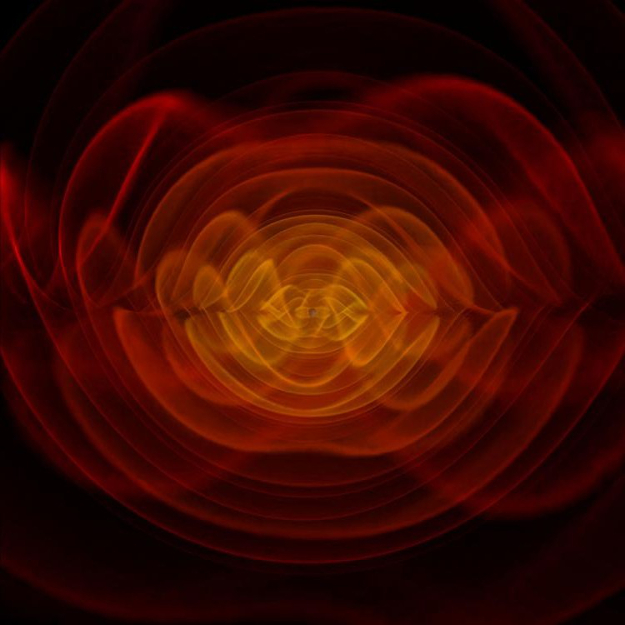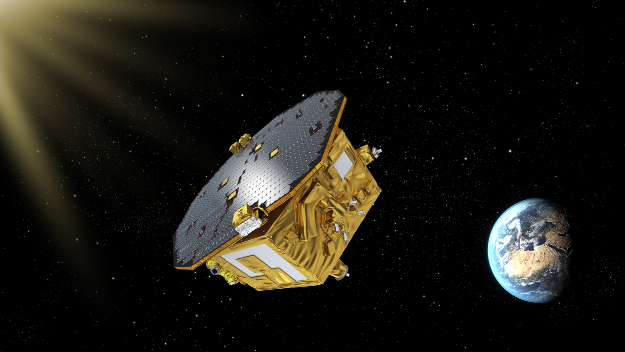On 2 December 2015 the European Space Agency ESA will launch the satellite LISA Pathfinder, an important technology demonstration mission for measuring the gravitational waves in space predicted by Einstein. With gravitational waves scientists expect to be able to make new discoveries about objects such as compact binary stars and merging supermassive black holes, which are responsible for the biggest bangs after the Big Bang. And completely new fundamental physics is also on the horizon.

Back in 1916, Albert Einstein predicted the existence of gravitational waves. He proposed that gravity was a deformation in space-time: the heavier the object, the stronger the deformation of the space-time around it. Furthermore, two extremely heavy objects that rapidly rotate around each other or collide, such as merging supermassive black holes, ought to cause ripples in that space-time. Einstein thought that this tiny effect could never be measured. However thanks to new precision technology, researchers can now go in search of these waves that travel through the universe at the speed of light.
“Gravitational waves provide a unique new window on the universe,” says Gijs Nelemans (Radboud University/Nikhef), leader of the Dutch consortium working on eLISA, the planned big brother of Pathfinder (see below). “In contrast to ordinary electromagnetic radiation, gravitational waves travel through everything, from the sources straight to the detectors. It is a completely new way of studying extreme objects in space.”
Technology test
Most objects emit gravitational waves that can only be detected in space. The European Space Agency ESA therefore selected the eLISA mission (evolved Laser Interferometer Space Antenna) at the end of 2013. eLISA will be launched in about 2034. LISA Pathfinder will first of all test the precision technology of eLISA. The measurement principle revolves around determining the distance between freely moving test masses by using laser interferometry.
LISA Pathfinder has two gold-platinum blocks on board, almost 40 cm apart, which freely float in the satellite. That is too close together to be able to detect gravitational waves yet. The aim is to demonstrate that the two gold-platinum blocks remain in free-fall, unaffected by any disruptions that are not caused by gravity. The researchers realize this by measuring the distance between the two blocks with atomic precision. For this, laser light is used as a super-accurate ruler in just the same way as will be done in eLISA.
Fundamental physics
“Hopefully the variation in the distance that LISA Pathfinder measures between the blocks is almost zero,” says SRON researcher Martijn Smit. “Because then we know that the blocks are indeed floating around undisturbed. Subsequently when they are placed at an enormous distance from each other in eLISA, we will still see only the variations that are caused by gravitational waves. And that is the intention.”

“If this technology lives up to its promise then the way is clear for eLISA,” says Nelemans. “With eLISA astronomers will be able to study compact binary stars in the entire Milky Way and merging supermassive black holes beyond the furthest galaxies we currently know. However the mission will probably also result in new fundamental physics. We might even discover new evidence for the inflation theory. In effect we are looking at everything that is shaking up the structure of space.”
Launch
Pathfinder’s launch is planned for 2 December from the European launch site in Kourou in French Guiana, onboard a Vega carrier rocket. The European Space Agency ESA expects that Pathfinder will arrive at its final orbit around the sun, 1.5 million km from earth, at the start of 2016.
The Netherlands
Dutch engineers and scientists are closely involved in both missions. In the run-up to the launch, SRON has developed test equipment for LISA Pathfinder. TNO has already developed and tested various systems including a system that ensures the laser beams of eLISA end up at exactly the right place, even over a distance of 5 million km. As a member of the LIGO Virgo Collaboration (since 2007) Nikhef is closely involved in gravitational wave research. “In the future we are looking to improve the Advanced Virgo precision technology for eLISA,” says Jo van den Brand, project leader gravitational waves at Nikhef. Nikhef, TNO, NOVA, University of Twente, and SRON are working together on the development of the technology for eLISA.
To study gravitational waves researchers from Nikhef, Radboud University, University of Amsterdam, Leiden University, University of Groningen, VU University Amsterdam and SRON have joined forces. In addition to eLISA they will make measurements with the Italian/French/Dutch VIRGO detector, the Dutch BlackGEM telescope, and the European Pulsar Timing Array, which will observe gravitational waves from other frequencies and their electromagnetic counterparts.


